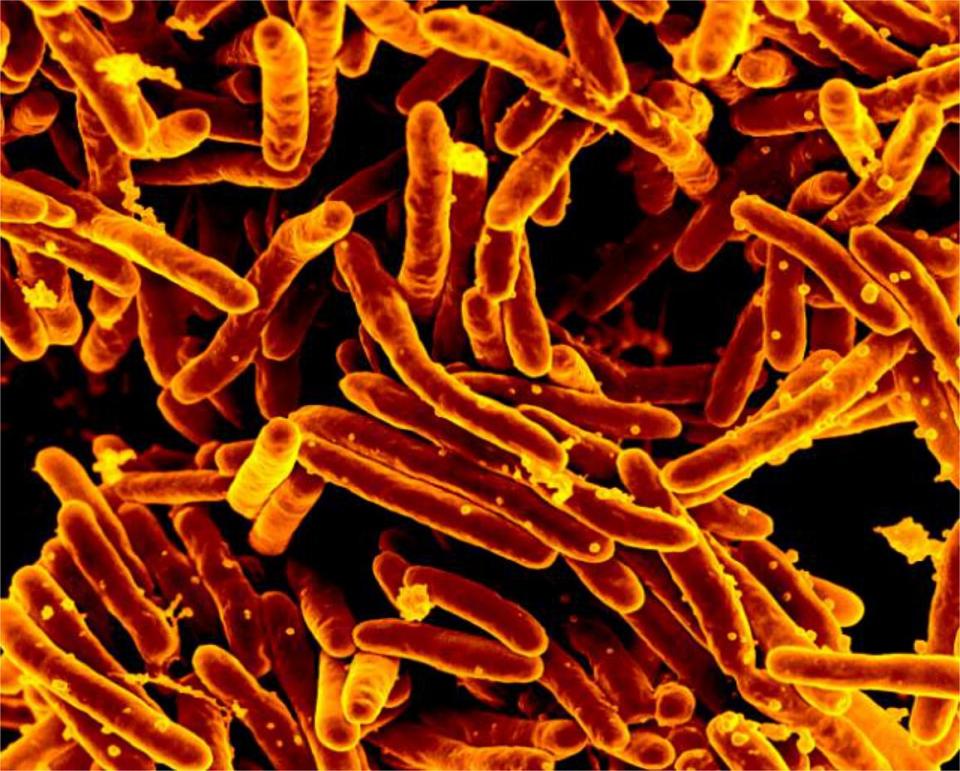Tuberculosis cases are way up in Worcester: Should residents be concerned?
WORCESTER ― On the surface, it might look like Worcester is facing a dangerous public health crisis.
Tuberculosis cases in the city have skyrocketed, from 11 cases in 2019 to 1,154 cases last year, according to the city's Public Health Department. That represents a whopping 10,390% increase over the five-year period.
Tuberculosis bacteria can enter in the lungs and infection can occur, resulting in coughing and sneezing that sends the bacteria into the air. Those in close contact can breathe in the bacteria and become infected. TB can turn fatal: The U.S. Centers for Disease Control and Prevention report a total of 602 TB-related deaths nationally in 2021, the latest year for which mortality numbers are available.

While the local TB numbers appear alarming, some experts said residents shouldn't be overly concerned about getting the disease.
Amelia Houghton, the city's chief public health nurse, said "no" when asked if the numbers represent a serious concern for Worcester residents. She said not all of the 1,154 cases are active ones that spread the disease. Some cases are confirmed and latent. Others are probable and suspect, and some turn out to be negative for the disease.
Houghton said the department is looking into why the numbers have increased so dramatically. She didn't immediately have a breakdown of the number of active and latent cases among the 1,154 total. In addition, the department didn't have demographic information to indicate categories like race/ethnicity, gender and age. The Telegram & Gazette is awaiting a reply to a public records request to the state health department to access that information.
'Very low' risk
Dr. Sandeep Jubbal, an infectious disease physician in the UMass Memorial Health infectious disease clinic, said there is "no doubt" Worcester is seeing an increase in TB cases. But the risk that Worcester residents will get the disease is "very low."
The total number of yearly TB visits to the UMass clinic, including latent, active and suspect, were 1,106 in 2021, 1,428 in 2022 and 2,048 in 2023.

Jubbal said patients tested in the clinic are immediately put into treatment when there is a positive result. Medication is administered and patients are isolated in the hospital for two weeks to eradicate the TB bacteria in their bodies. Isolation can also happen at home, and a visiting nurse ensures the regimen is followed.
The vast majority of TB infections are not communicable, noted Dr. Richard Ellison, an infectious disease physician at UMass. While recent studies estimate that 25% of the global population has been infected with TB, roughly 90% of the infections are latent and the person never becomes ill.
But there appear to be holes in the system for identifying who has TB and controlling its spread. Undocumented immigrants from countries where TB is endemic could spread the disease. Also, when a latent patient tests positive, there is no law that mandates they accept treatment, according to Jubbal.
Federal law requires that any child or adult applying for an immigrant visa to enter the U.S. needs an overseas medical exam, including testing for TB.
COVID-19 pandemic a factor
Jubbal mentioned the COVID-19 pandemic as a possible explanation for Worcester's rising TB numbers. Lockdowns and limits on travel and immigration during the height of the pandemic are no longer in effect, so the risk of contracting TB has increased.
Jubbal also noted wars in Afghanistan and Ukraine are bringing more immigrants into Worcester. While those immigrants are screened for TB because they're processed through official government channels, there is a risk that some of the arrivals could have latent TB. Up to 10% of latent cases can become active disease.
Nationally, TB is on the rise, with 8,331 cases reported in 2022, a 5.9% increase over 2021, according to the CDC. It is unclear if 8,331 is just active cases or includes latent cases. About 10 million people have active TB worldwide, according to the American Lung Association.
The CDC noted mandated isolation and limits on immigration and travel during the pandemic could have contributed to keeping reported numbers down.
Residents can protect themselves against TB, said Jubbal, by keeping a safe distance and limiting the amount of time they're in close contact with someone who is coughing. "It's not like if someone has TB you're going to get an infection. The burden is the bacteria coughed out and how long you're inhaling air with droplets with the bacteria in it," he said.
Active TB in Worcester tops statewide average
Worcester had a total of 43 active TB cases from 2018 to 2022, according to the latest published data by the state health department: eight cases in 2022, 10 cases in 2021, five cases in 2020, seven cases in 2019 and 13 cases in 2018.
Worcester nearly doubled the statewide average in active disease cases over that five-year span: 4.4 cases per 100,000 people, compared to 2.4 per 100,000 people statewide. Other big cities in Massachusetts that exceeded the statewide average over the same five-year period included Boston (4.6 per 100,000), Cambridge (4.6 per 100,000), Lowell (6.4 per 100,000) and Brockton (4.8 per 100,000).
Tuberculosis details
TB is a bacterium that normally enters the lungs but can also attack the kidney, spine and brain.
There are two types of TB. Active TB means the infection is in the lungs and can spread to others in close contact. Latent TB occurs when patients test positive but have no symptoms and a normal X-ray. They don't spread TB to others, and up to 10% of latent cases could progress to active TB.
People with weak immune systems, especially those with HIV infection, face a greater risk of contracting the disease.
Symptoms of active TB include coughing and sneezing, and those symptoms send bacteria into the air that others can breathe in, resulting in an active or latent case. Symptoms can also include chest pain, fatigue, weight loss, fever and night sweats.
Unlike COVID-19, a virus that can be contracted during a relatively quick period by inhaling aerosol droplets, it takes longer for a TB infection to take hold. Generally, those who spend considerable time every day around someone with TB disease, like household members or classmates, face an increased risk of exposure.
Diagnosis of TB is done by a skin or blood test. One treatment involves what Houghton called a “cocktail” of drugs known by the acronym RISE, that includes Rifampin, Isoniazid, Pyrazinamide and Ethambutol.
Until recently, the main way to diagnose latent TB was skin testing, said Ellison. Reporting infections was done manually by hospitals and doctor's offices. It was cumbersome and likely incomplete. Today, diagnosis of latent TB has been mostly replaced by blood tests. This approach is more efficient and likely more accurate, said Ellison.
How does TB reporting system work?
The process starts when the state identifies TB cases through the Massachusetts Virtual Epidemiologic Network and assigns them to local public health departments.
When Worcester public health receives notification of active and suspected TB cases from the state, it refers them to the infectious disease clinic at UMass Memorial Health for testing.
There at three types of TB cases seen in the clinic: active, latent and suspect. The majority of active patients are born outside the U.S. in countries where TB is endemic, said Jabbal. They're diagnosed during immigration, during screening if their case is suspect, or during hospitalization.
Roughly one or two active cases yearly at the UMass clinic are undocumented immigrants. A handful of cases are patients born in the U.S. who have spent time in jail, use intravenous drugs, are immunocompromised or have HIV.
Suspect cases in the clinic are mostly new immigrants with an abnormal X-ray that indicates a suspicion of TB, said Jubbal. Doctors rule out the disease by checking a patient's mucus for bacteria or by taking a tissue biopsy. If the results are negative, the patient is declared TB negative.
Latent patients in the clinic were exposed to someone with active TB, but their immune system was able to capture and contain the bacteria. Approximately 25% of the world's population has latent TB, according to the CDC.
How are patients screened for TB?
Most immigrants get screened when they apply for a green card that permits an immigrant to live and work permanently in the U.S., according to Jubbal. They can also get screened by their employer, and the screening is a blood test. If it's positive, an X-ray is done and the patient is referred to the UMass clinic.
Suspicion of active infection triggers the clinic to notify the state health department and the patient's mucus is checked. If the X-ray is negative and there are no symptoms, the clinic offers treatment for latent TB that can be accepted or declined.
The UMass clinic sees roughly 20 to 25 new latent TB cases weekly, one to two suspected cases weekly, and an average of three to four new active cases monthly. The active cases come from notification by the state health department or during hospital admission.
Meanwhile, a change occurred in the groups of patients tested for latent TB, said Ellison. Previously, new immigrants to the U.S. were the primary focus of testing. Currently, testing includes patients receiving new, powerful biologic agents to treat inflammatory bowel disease, severe skin diseases and rheumatic diseases like rheumatoid and psoriatic arthritis.
These drugs suppress the immune system and increase the risk that a patient with latent TB will develop into active TB, according to Ellison.
Contact Henry Schwan at henry.schwan@telegram.com. Follow him on X: @henrytelegram.
This article originally appeared on Telegram & Gazette: Tuberculosis cases skyrocket in Worcester, but risk considered low

